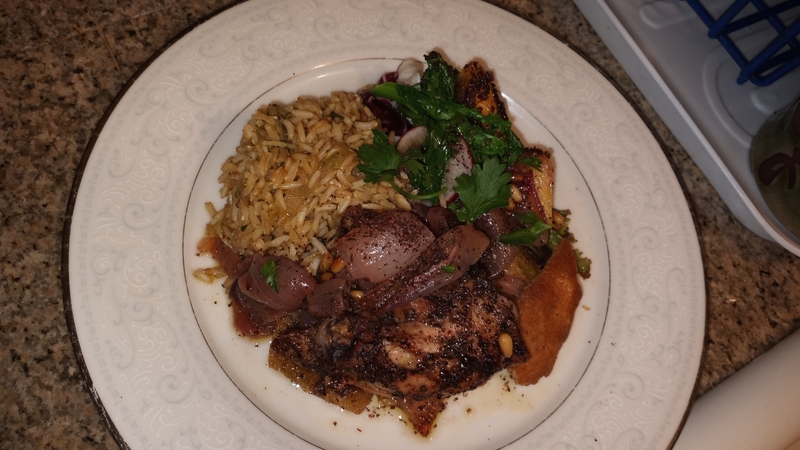
The process started out with the sumac spice, and memories of Jordan. I started going through all the recipes that sumac can be used in, and how I can combine them. I realized that two dishes are popular, fattoush and mussakhan. The salad and meat combined very well together as well as sumac spice. After that, I wrote all the ingredients down on a piece of paper. Also, looked into the flavor matrix book, and how to eat a peach by Diana Henry for guidance.
Mussakhan – roasted chicken thigh with sumac and red onions

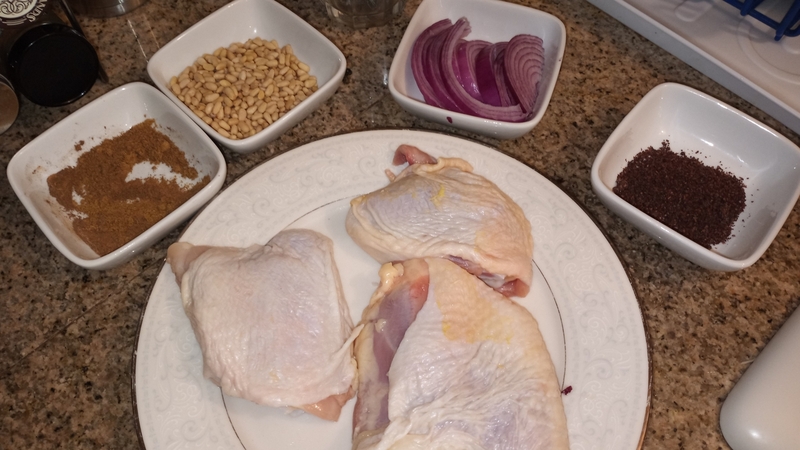
The inspiration for this dish comes from back home, Jordan. The dish is Palestinian in origin, but Jordanians cook it as well. I used my knowledge from my childhood, plus some tweaking like adding cinnamon spice. The cinnamon gives it a nice sweetness. The cuisine style is middle eastern, and sumac is the main reason I chose this recipe. The sumac flavor profile gives a citrus, zesty, tart zing without the acidity of the lemon. I love this berry. It’s versatile; adding to salads is another option like Fattoush. I will be also making the salad with sumac. Sumac is one of my favorite spices that I always have on hand. Great substitute to lemon. The red onions will give a nice, sweet flavor that will balance out the citrus flavor of the sumac with a nice crunchy texture from the pine nuts. The spices will also add a nice overall sweetness from the cinnamon, and earthy flavor from the cumin and all spice. The roasting of the chicken, and caramelized onions will bring all the flavors together in the oven at 375 F. Lastly, I’ll be pan frying the pine nuts on the stovetop, so they don’t get burned in the oven.
Ingredients:
Three chicken thighs, 1 tbsp all spice, 4 tbsp sumac (less or more depending on how tangy you like it), 1 tbsp cinnamon, 1 tbsp cumin, 1/2 cup olive oil + more to drizzle on top if you feel like it, 1 tsp sea salt, 3 tbsp + more I love to add more! pine nuts, and 1 – 2 red onions. The dish comes with taboon flat bread similar to tandoori bread but much thinner. If you can’t find it; rice can be used instead.
Knife cuts and method:
Cut the chicken thighs from a whole chicken if possible. This gives a nice flavor for the final dish. I find whole chicken to taste much better than ones that are already cut. Slice the red onions into thin slices. Pan fried the pine nuts with olive oil. Flip the pan to distribute the heat to prevent pine nuts from burning. For the chicken, make sure it is patted dry before cooking, and slightly use a spoon or a flat Kitchenware to even the meat out. This will help cook it evenly.
Jasmine brown rice verde
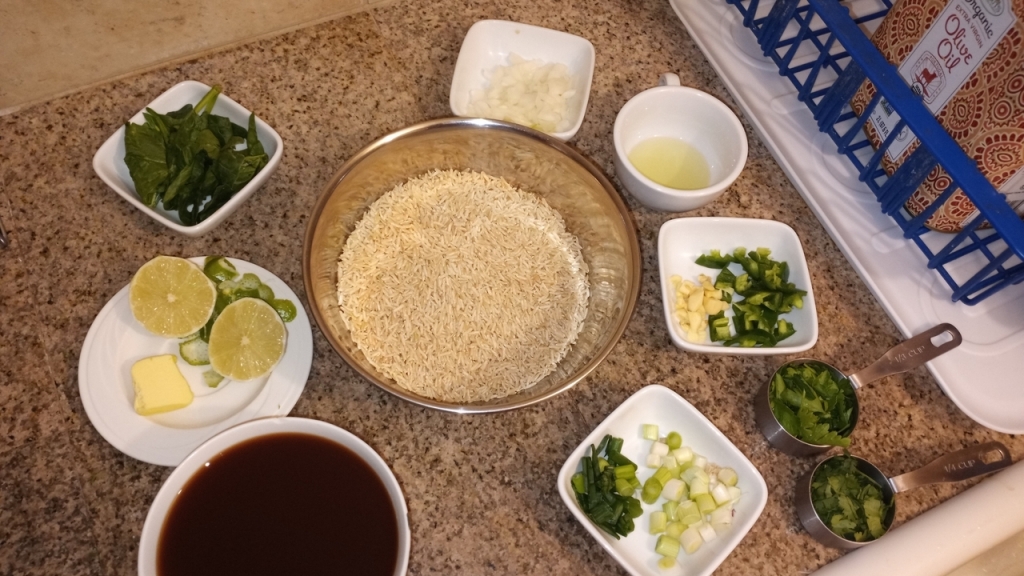
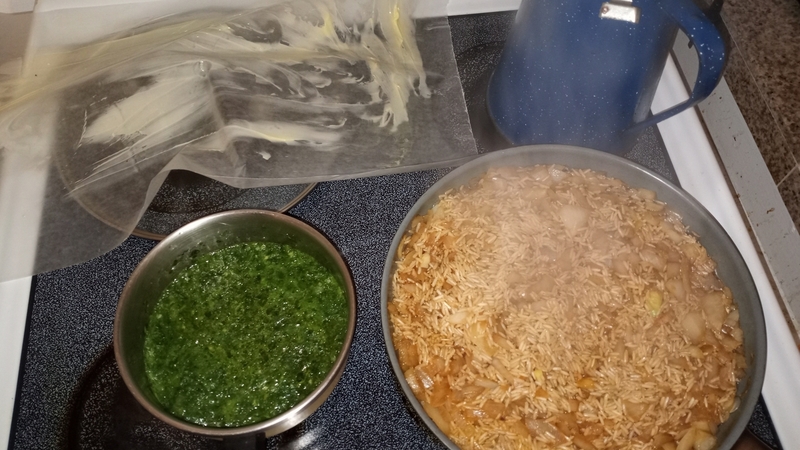
The flavor profile for the dish is earthy from parsley and spinach, citrusy from the lime, sweet from the onions, spicy from the green chiles, and sweet flavor from the vegetable stock. The risotto method gives the dish a flavor that is velvety with a al dente since it is cooked over low heat. Also, this gives the sauce a soft texture. Such a nice complement to my roasted chicken dish.
Ingredients:
Jasmine long grain brown rice (amount depends on the package), 2 – 3 green onions, 2 – 3 garlic, 1 green chiles, 1 bunch cilantro, 1 bunch parsley, 1 lime, 1 tbsp unsalted butter, 2 – 3 tbsp grapeseed oil (or any other neutral oil), 1 yellow onions, 1 cup spinach, and 2 cups vegetable stock.
The green onions are cut into medium dice, garlic and green chile cut into medium dice, and diced onions.
Method:
I blended the cilantro, garlic, scallions, spinach, and herbs in a blender. I added water to make a puree then cooked the green puree on the stovetop for a few minutes. The green sauce only needs to be cooked until the garlic smell is gone. Lastly, I added the green sauce on top of the rice. For the rice, I used the risotto method, added lime juice, and the zest at the end. Wash the rice until the water runs clear. Heat half of the oil of your choice. Neutral oils like peanut or grapeseed oil are the best for this recipe. Sauté the onions until it’s soft but not caramelized. Add the rice and mix it together. Cook it for a couple of minutes then add the vegetable stock. Boil the rice until the surface of the rice is cooked slightly. There will be air holes on the surface of the rice. Add the cooked green sauce to the rice. The recipe asked to cover the rice with parchment paper and unsalted butter with the lid at the end, and heat turned off for about 5 minutes. This gives a nice moisture to the rice.
Fattoush salad with blanched broccoli rapini

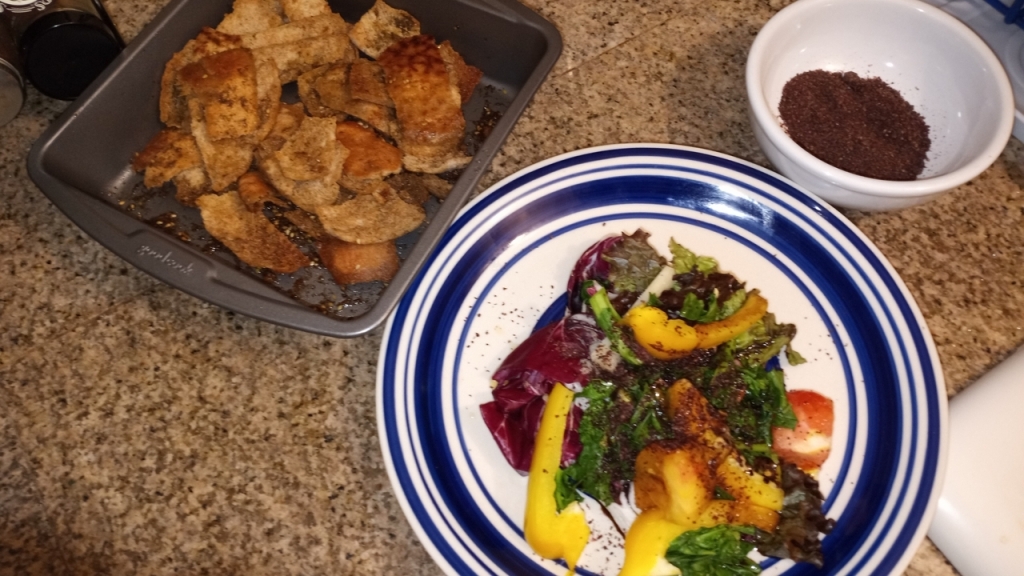
The flavor profile is citrusy, zesty, tangy from the sumac with an earthy flavor from the za’atar on the toasted pita bread. Ingredients include the sharp flavor of pecorino romano on top, bitter taste of pomegranate juice, olive oil vinaigrette mixture, with a crunch from the yellow peppers, and bitterness of the rapini. Also, a nice touch of sweetness from the tomatoes, and a crunch from the toasted pita bread. The fattoush salad complements the mussakhan. I wanted to use the sumac spice in another dish that also has a middle eastern flavor. Fattoush salad is the perfect dish because you can use any ingredient in the fridge. Hence the name is translated to “look for” in this case, look for ingredients.
knife cuts:
Sliced radishes, medium cut heirloom tomatoes, medium cut yellow peppers, and tear radicchio and romaine lettuce leaves.
Ingredients and method:
4- 5 tbsp sumac (personal preference), few slices of pecorino romano for garnish, a mixture of pomegranate molasses and olive oil to make the vinaigrette, 1 yellow peppers, 1 bunch rapini or broccoli rabe, 1 heirloom tomatoes, 4 radishes, 4 pita bread loaves depending on how much you like sprinkled on your salad, 1 bunch radicchio, and romaine lettuce.
Blanch broccoli rapini for 4 to 5 minutes uncovered then a few minutes in the ice bath. Don’t leave the broccoli rapini in ice bath for too long. Blanching keeps the color of the vegetables for the final dish. With only minimal cooking, just blanching the green veggie uncovered, then adding the acid at the end so the green color doesn’t fade away. For the pita bread, drizzle olive oil, sprinkle za’atar on top, place in the middle rack until golden brown at 350F. Assemble the salad and top off with toasted pita bread.
Reference
- How to eat a peach by Diana Henry, page 138.
2. The Flavor matrix by James Briscione, page 54.
Where to buy ingredients:
Here is a good brand for pomegranate molasses
This is a good Za’atar website.
I usually buy sumac from any Arabic grocery stores, but you can find it online. Here is a good one.

Great post! You know, I’ve been dwelling on this entry – and I realized that it reminded me of a dish I tried out at a now-defunct Turkish joint here in Manila. That dish – Chicken Pirzola – used the same spices!
I still remember the owner (Chef Mehmet was his name, if memory serves me correctly) letting me try out some of the sumac, which had a rather distinctive scent. Unfortunately, he closed down the joint here in the Philippines and went back to his home country some years ago.
LikeLiked by 1 person
Interesting. It’s used in different cuisines; makes sense.
LikeLiked by 1 person
Pingback: Food and culture | Living Well In The 21st Century
Pingback: Sumac — history, chemistry, and more | Living Well In The 21st Century
Pingback: Spices-Part 2 | Living Well In The 21st Century